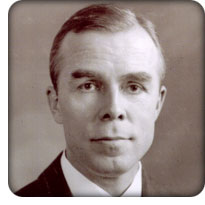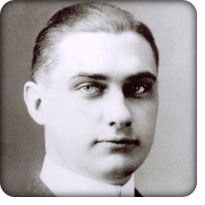

 One of the fathers of the American educational system, James Bryant Conant
believed in creating a governing, intellectual elite, chosen by standardized
tests and specially educated. His ideal was a classless and democratic
society.
One of the fathers of the American educational system, James Bryant Conant
believed in creating a governing, intellectual elite, chosen by standardized
tests and specially educated. His ideal was a classless and democratic
society.
Appointed president of Harvard College in 1933, Conant aimed to make the
school a more egalitarian institution. Soon after his appointment, Conant
established a scholarship program for students from modest backgrounds. He
ordered two assistants, Wilbur Bender and Henry Chauncey, to find a way to
assess the academic promise of the potential scholarship students. Chauncey
eventually recommended the Scholastic Aptitude Test, developed by Carl Brigham,
a psychology professor at Princeton.
In 1937 Conant recommended that a new national testing agency be created to
operate all the leading standardized educational tests. He espoused his beliefs
in a series of articles for the Atlantic Monthly. In the third of this
series, entitled "Wanted: American Radicals," Conant wrote that the American
radical "believes in equality of opportunity, not equality of rewards." After
World War II, he arranged for all of the major testing organizations in the
country to merge into one private, non-profit organization, the Educational
Testing Service (ETS).
Conant also played a key role in the expansion of ETS. In 1947, before ETS was
chartered, Conant set up a west-coast branch office in Berkeley. When ETS was
officially established January 1, 1948, Conant was the first Chairman of the
Board.
After his Harvard presidency ended in 1953, Conant moved out of the educational
world and into diplomacy. He became the U.S. high commissioner for Germany and
was then the ambassador to West Germany from 1955-1957.


 As a member of the American aristocracy Conant hoped to abolish, Henry
Chauncey was an unlikely ally in the fight to equalize opportunities at
Harvard. He did however, have an interest in intelligence tests, and by the
time Conant assigned him to find a way to select scholarship students in 1933,
Chauncey was a devout advocate of standardized testing.
As a member of the American aristocracy Conant hoped to abolish, Henry
Chauncey was an unlikely ally in the fight to equalize opportunities at
Harvard. He did however, have an interest in intelligence tests, and by the
time Conant assigned him to find a way to select scholarship students in 1933,
Chauncey was a devout advocate of standardized testing.
It was Chauncey who brought the SAT to Conant as a solution for his dilemma of
finding qualified scholarship students. He also convinced Conant that the test
was an accurate measure of intelligence, not just of the quality of a test
taker's education. Harvard began using the test for scholarship students in
1934 and, starting in 1941, required it for all applicants.
In 1943, Chauncey contracted with the Army and Navy to administer an adapted
SAT to over 300,000 people across the country in one day for help in officer
selection. His achievement for the military demonstrated that it was possible
to use the SAT to assess all high school students in the country.
When Conant established ETS after the war, Chauncey became its first
president. Before World War II, the number of SAT takers never exceeded 20,000
in a given year. By the time Chauncey retired in 1970, more than 1.5 million
people took the SAT annually.
Throughout his tenure at ETS, Chauncey worked to institute a monumental project
he called the "Census of Abilities," designed to test every American citizen
twice during their high school years on a number of attributes. His goal was to
use the results of the tests to advise the students on what they should do with
their lives, thus saving them from the pain and suffering of not knowing their
lot in life. Chauncey never achieved his plan, largely because no one would
fund it.


 Carl C. Brigham, the father of the SAT, became interested in mental testing
while a student a Princeton. He later became a psychology professor at the
university, where he was an enthusiastic member of the eugenics movement.
During the 1920s he developed his own objective admissions test for students
applying to Princeton.
Carl C. Brigham, the father of the SAT, became interested in mental testing
while a student a Princeton. He later became a psychology professor at the
university, where he was an enthusiastic member of the eugenics movement.
During the 1920s he developed his own objective admissions test for students
applying to Princeton.
Brigham later worked on the Army Alpha Test, an intelligence test given to
millions of recruits during World War I. In 1923, he wrote A
Study of American Intelligence, which analyzed the findings of the
Alpha Test by race. Its conclusion, which Brigham insisted was without
prejudice, was that American education was declining and "will proceed with an
accelerating rate as the racial mixture becomes more and more extensive."
Eventually Brigham adapted the Army Alpha Test for use in college admissions,
renaming it the Scholastic Aptitude Test. Brigham's work interested Henry
Chauncey and Bill Bender, assistants to James Conant at Harvard. Starting in
1934, Harvard adopted the SAT to select scholarship recipients at the
school.
Brigham later repudiated much of his book, doubting the idea that there is
universal human intelligence quotient. He also opposed the formation of the
Educational Testing Service.

home |
discussion |
who got in? |
interviews |
the race issue |
sat & test prep |
history of the sat
the screening process |
test score gap |
getting in to berkeley |
bibliography |
links |
tapes & transcripts |
press |
synopsis
FRONTLINE |
pbs online |
wgbh
 |